Strategy Evaluation for Desklib Online Library
VerifiedAdded on 2023/06/18
|12
|3836
|57
AI Summary
This report on Desklib online library discusses the evaluation of mission, vision and objectives in strategic direction, competitive advantage analysis using VRIO framework, external factors in regard to organisation, Porter's five forces and more. The report focuses on Waitrose, one of the most successful international retail brands headquartered in the UK.
Contribute Materials
Your contribution can guide someone’s learning journey. Share your
documents today.
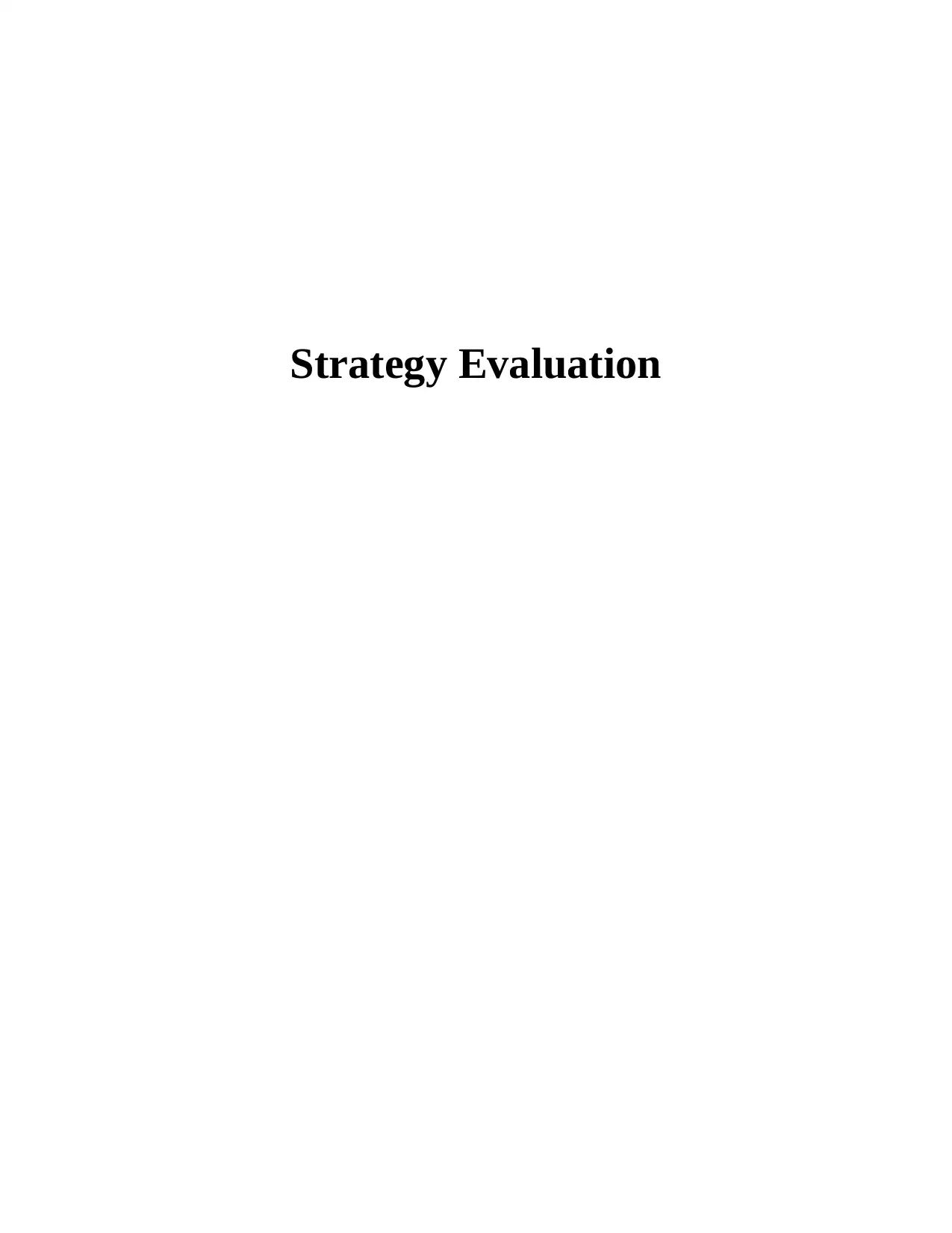
Strategy Evaluation
Secure Best Marks with AI Grader
Need help grading? Try our AI Grader for instant feedback on your assignments.
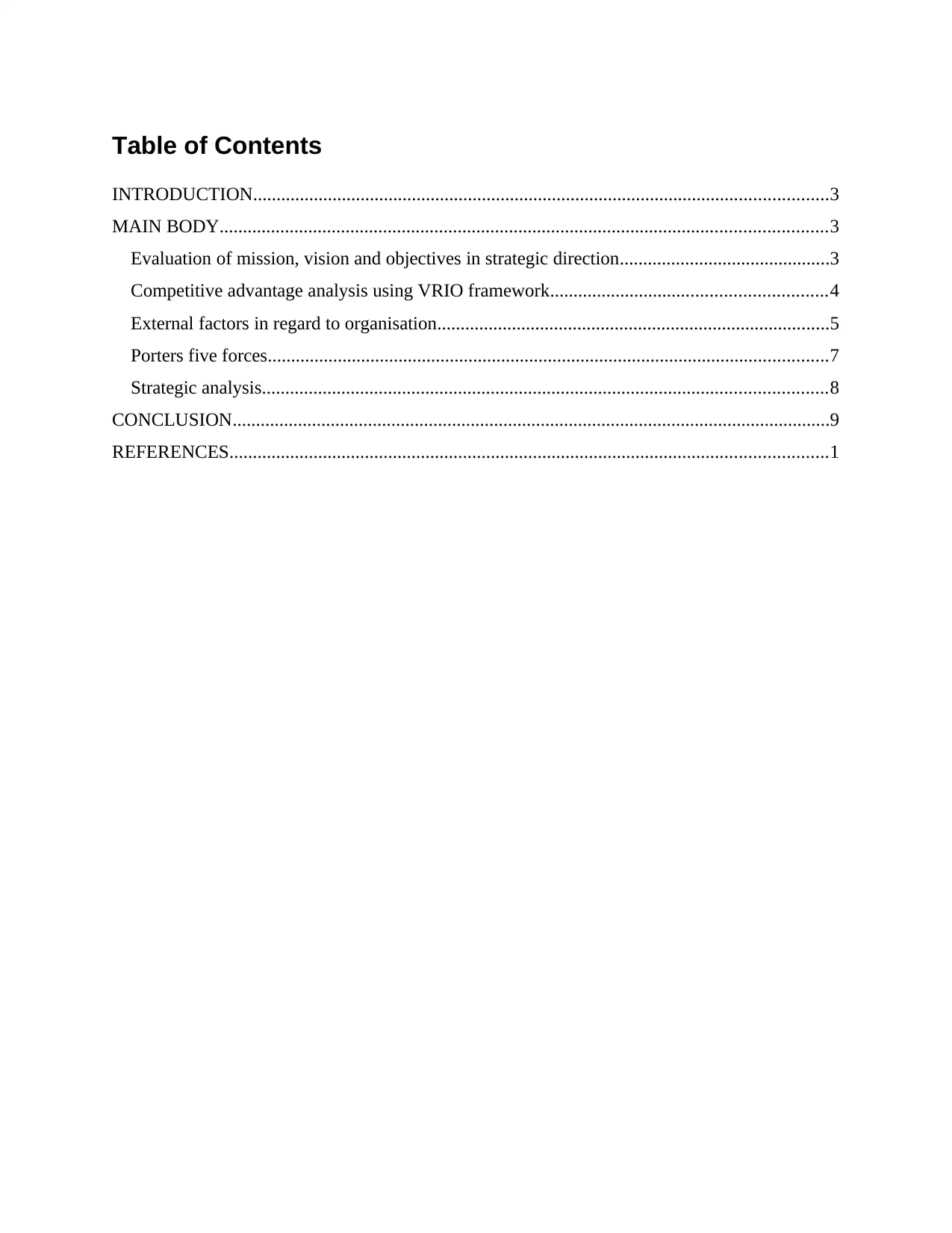
Table of Contents
INTRODUCTION...........................................................................................................................3
MAIN BODY..................................................................................................................................3
Evaluation of mission, vision and objectives in strategic direction.............................................3
Competitive advantage analysis using VRIO framework...........................................................4
External factors in regard to organisation....................................................................................5
Porters five forces........................................................................................................................7
Strategic analysis.........................................................................................................................8
CONCLUSION................................................................................................................................9
REFERENCES................................................................................................................................1
INTRODUCTION...........................................................................................................................3
MAIN BODY..................................................................................................................................3
Evaluation of mission, vision and objectives in strategic direction.............................................3
Competitive advantage analysis using VRIO framework...........................................................4
External factors in regard to organisation....................................................................................5
Porters five forces........................................................................................................................7
Strategic analysis.........................................................................................................................8
CONCLUSION................................................................................................................................9
REFERENCES................................................................................................................................1
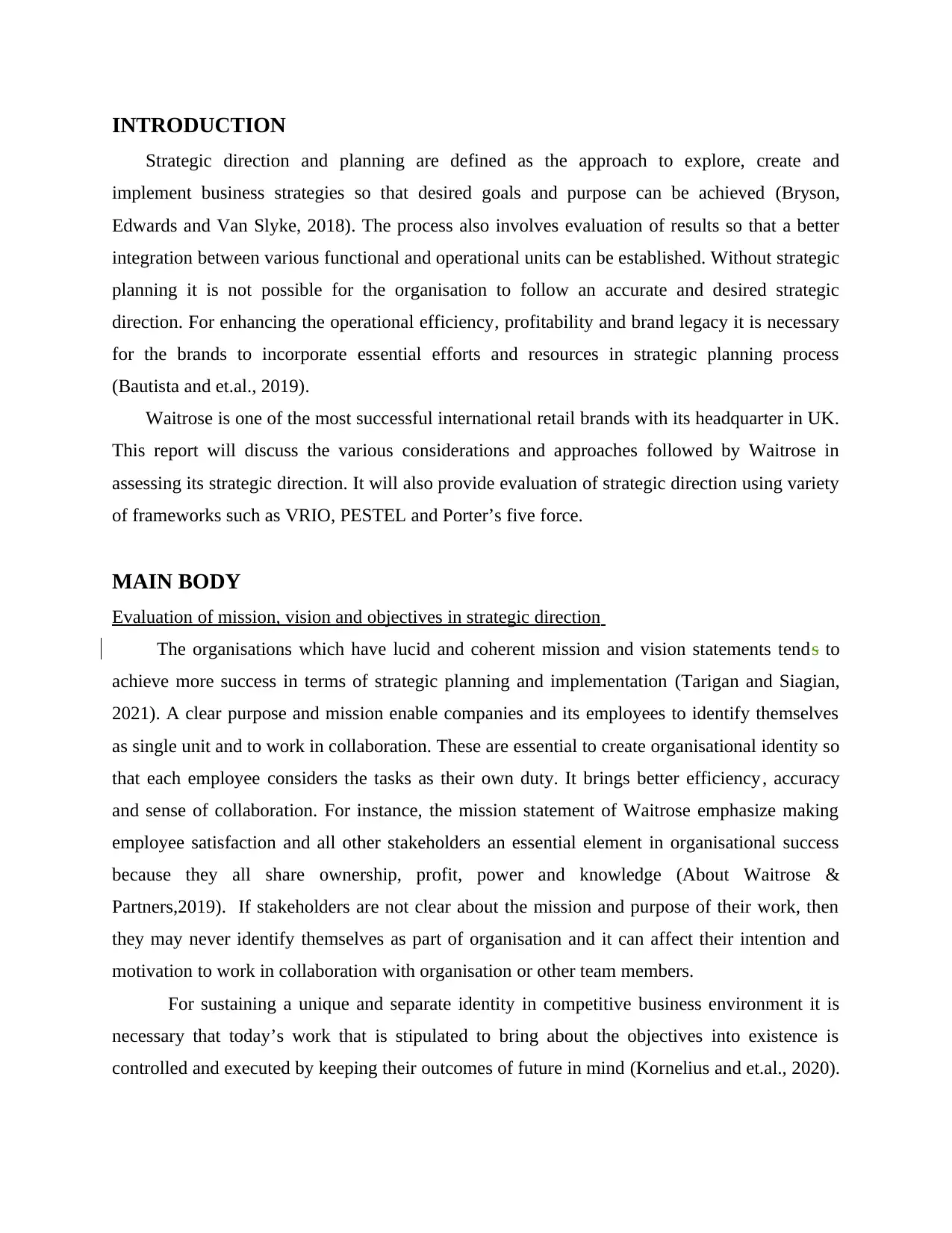
INTRODUCTION
Strategic direction and planning are defined as the approach to explore, create and
implement business strategies so that desired goals and purpose can be achieved (Bryson,
Edwards and Van Slyke, 2018). The process also involves evaluation of results so that a better
integration between various functional and operational units can be established. Without strategic
planning it is not possible for the organisation to follow an accurate and desired strategic
direction. For enhancing the operational efficiency, profitability and brand legacy it is necessary
for the brands to incorporate essential efforts and resources in strategic planning process
(Bautista and et.al., 2019).
Waitrose is one of the most successful international retail brands with its headquarter in UK.
This report will discuss the various considerations and approaches followed by Waitrose in
assessing its strategic direction. It will also provide evaluation of strategic direction using variety
of frameworks such as VRIO, PESTEL and Porter’s five force.
MAIN BODY
Evaluation of mission, vision and objectives in strategic direction
The organisations which have lucid and coherent mission and vision statements tends to
achieve more success in terms of strategic planning and implementation (Tarigan and Siagian,
2021). A clear purpose and mission enable companies and its employees to identify themselves
as single unit and to work in collaboration. These are essential to create organisational identity so
that each employee considers the tasks as their own duty. It brings better efficiency, accuracy
and sense of collaboration. For instance, the mission statement of Waitrose emphasize making
employee satisfaction and all other stakeholders an essential element in organisational success
because they all share ownership, profit, power and knowledge (About Waitrose &
Partners,2019). If stakeholders are not clear about the mission and purpose of their work, then
they may never identify themselves as part of organisation and it can affect their intention and
motivation to work in collaboration with organisation or other team members.
For sustaining a unique and separate identity in competitive business environment it is
necessary that today’s work that is stipulated to bring about the objectives into existence is
controlled and executed by keeping their outcomes of future in mind (Kornelius and et.al., 2020).
Strategic direction and planning are defined as the approach to explore, create and
implement business strategies so that desired goals and purpose can be achieved (Bryson,
Edwards and Van Slyke, 2018). The process also involves evaluation of results so that a better
integration between various functional and operational units can be established. Without strategic
planning it is not possible for the organisation to follow an accurate and desired strategic
direction. For enhancing the operational efficiency, profitability and brand legacy it is necessary
for the brands to incorporate essential efforts and resources in strategic planning process
(Bautista and et.al., 2019).
Waitrose is one of the most successful international retail brands with its headquarter in UK.
This report will discuss the various considerations and approaches followed by Waitrose in
assessing its strategic direction. It will also provide evaluation of strategic direction using variety
of frameworks such as VRIO, PESTEL and Porter’s five force.
MAIN BODY
Evaluation of mission, vision and objectives in strategic direction
The organisations which have lucid and coherent mission and vision statements tends to
achieve more success in terms of strategic planning and implementation (Tarigan and Siagian,
2021). A clear purpose and mission enable companies and its employees to identify themselves
as single unit and to work in collaboration. These are essential to create organisational identity so
that each employee considers the tasks as their own duty. It brings better efficiency, accuracy
and sense of collaboration. For instance, the mission statement of Waitrose emphasize making
employee satisfaction and all other stakeholders an essential element in organisational success
because they all share ownership, profit, power and knowledge (About Waitrose &
Partners,2019). If stakeholders are not clear about the mission and purpose of their work, then
they may never identify themselves as part of organisation and it can affect their intention and
motivation to work in collaboration with organisation or other team members.
For sustaining a unique and separate identity in competitive business environment it is
necessary that today’s work that is stipulated to bring about the objectives into existence is
controlled and executed by keeping their outcomes of future in mind (Kornelius and et.al., 2020).

Thus, a clear mission and objective helps individuals to understand that in which direction they
want to take organisation in future. For instance, Waitrose
3
has its one of the business objectives to enhance its market share by 3.7% within one year (Leyva
Carreras, Cavazos Arroyo and Espejel Blanco, 2018). The selection of such objectives guides
organisation and management to accomplish various strategies such as growth, expansion and
development. Well- defined objectives also bring accountability and sense of responsibility
among individuals to enhance and steer their efforts for betterment. If company does not have
clarity in purpose or objectives, then team members and leaders will never be able to identify or
select the most suitable strategic direction which can give competitive benefit or strategical
success (Rizan, Balfas and Purwohedi, 2019). When organisational objectives are known in
advance then the company is also able to well utilise and manage its resources so that resource
related barriers does not hinder the strategic process and implementation.
Competitive advantage analysis using VRIO framework
In order to assess the competitive advantage Waitrose uses framework like VRIO so that it
can identify and assess the effectiveness of its resources. Thus it helps organisations to develop
strategies which can optimise the productivity and efficiency.
Resources Valuable (V) Rare (R) Inmitable (I) Organised (O)
Human
resources
Yes X Yes Yes
Technical Yes X X Yes
Financial Yes X Yes Yes
Brand value Yes Yes X X
Innovation Yes X X X
Valuable: Some resources of organisation are highly valuable and thus while formulating and
implementing strategies organisation must ensure that they are explored fully (Teixeira and
Junior, 2019). All technical, HR, finance and innovation resources of Waitrose are valuable and
possess huge potential to generate value. Thus development strategies focus on improving these
resources so that company is able to achieve its objectives easily.
want to take organisation in future. For instance, Waitrose
3
has its one of the business objectives to enhance its market share by 3.7% within one year (Leyva
Carreras, Cavazos Arroyo and Espejel Blanco, 2018). The selection of such objectives guides
organisation and management to accomplish various strategies such as growth, expansion and
development. Well- defined objectives also bring accountability and sense of responsibility
among individuals to enhance and steer their efforts for betterment. If company does not have
clarity in purpose or objectives, then team members and leaders will never be able to identify or
select the most suitable strategic direction which can give competitive benefit or strategical
success (Rizan, Balfas and Purwohedi, 2019). When organisational objectives are known in
advance then the company is also able to well utilise and manage its resources so that resource
related barriers does not hinder the strategic process and implementation.
Competitive advantage analysis using VRIO framework
In order to assess the competitive advantage Waitrose uses framework like VRIO so that it
can identify and assess the effectiveness of its resources. Thus it helps organisations to develop
strategies which can optimise the productivity and efficiency.
Resources Valuable (V) Rare (R) Inmitable (I) Organised (O)
Human
resources
Yes X Yes Yes
Technical Yes X X Yes
Financial Yes X Yes Yes
Brand value Yes Yes X X
Innovation Yes X X X
Valuable: Some resources of organisation are highly valuable and thus while formulating and
implementing strategies organisation must ensure that they are explored fully (Teixeira and
Junior, 2019). All technical, HR, finance and innovation resources of Waitrose are valuable and
possess huge potential to generate value. Thus development strategies focus on improving these
resources so that company is able to achieve its objectives easily.
Secure Best Marks with AI Grader
Need help grading? Try our AI Grader for instant feedback on your assignments.
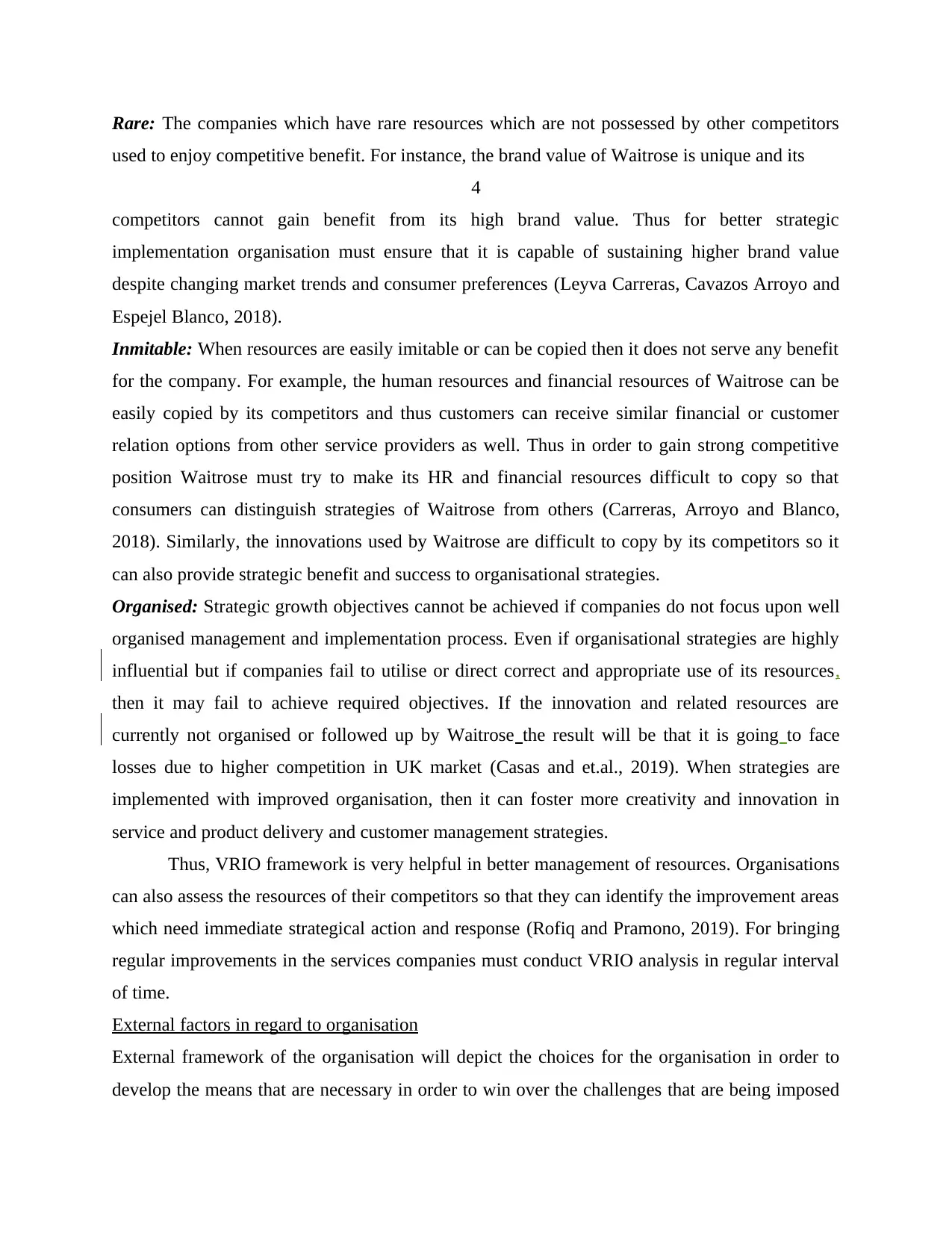
Rare: The companies which have rare resources which are not possessed by other competitors
used to enjoy competitive benefit. For instance, the brand value of Waitrose is unique and its
4
competitors cannot gain benefit from its high brand value. Thus for better strategic
implementation organisation must ensure that it is capable of sustaining higher brand value
despite changing market trends and consumer preferences (Leyva Carreras, Cavazos Arroyo and
Espejel Blanco, 2018).
Inmitable: When resources are easily imitable or can be copied then it does not serve any benefit
for the company. For example, the human resources and financial resources of Waitrose can be
easily copied by its competitors and thus customers can receive similar financial or customer
relation options from other service providers as well. Thus in order to gain strong competitive
position Waitrose must try to make its HR and financial resources difficult to copy so that
consumers can distinguish strategies of Waitrose from others (Carreras, Arroyo and Blanco,
2018). Similarly, the innovations used by Waitrose are difficult to copy by its competitors so it
can also provide strategic benefit and success to organisational strategies.
Organised: Strategic growth objectives cannot be achieved if companies do not focus upon well
organised management and implementation process. Even if organisational strategies are highly
influential but if companies fail to utilise or direct correct and appropriate use of its resources,
then it may fail to achieve required objectives. If the innovation and related resources are
currently not organised or followed up by Waitrose the result will be that it is going to face
losses due to higher competition in UK market (Casas and et.al., 2019). When strategies are
implemented with improved organisation, then it can foster more creativity and innovation in
service and product delivery and customer management strategies.
Thus, VRIO framework is very helpful in better management of resources. Organisations
can also assess the resources of their competitors so that they can identify the improvement areas
which need immediate strategical action and response (Rofiq and Pramono, 2019). For bringing
regular improvements in the services companies must conduct VRIO analysis in regular interval
of time.
External factors in regard to organisation
External framework of the organisation will depict the choices for the organisation in order to
develop the means that are necessary in order to win over the challenges that are being imposed
used to enjoy competitive benefit. For instance, the brand value of Waitrose is unique and its
4
competitors cannot gain benefit from its high brand value. Thus for better strategic
implementation organisation must ensure that it is capable of sustaining higher brand value
despite changing market trends and consumer preferences (Leyva Carreras, Cavazos Arroyo and
Espejel Blanco, 2018).
Inmitable: When resources are easily imitable or can be copied then it does not serve any benefit
for the company. For example, the human resources and financial resources of Waitrose can be
easily copied by its competitors and thus customers can receive similar financial or customer
relation options from other service providers as well. Thus in order to gain strong competitive
position Waitrose must try to make its HR and financial resources difficult to copy so that
consumers can distinguish strategies of Waitrose from others (Carreras, Arroyo and Blanco,
2018). Similarly, the innovations used by Waitrose are difficult to copy by its competitors so it
can also provide strategic benefit and success to organisational strategies.
Organised: Strategic growth objectives cannot be achieved if companies do not focus upon well
organised management and implementation process. Even if organisational strategies are highly
influential but if companies fail to utilise or direct correct and appropriate use of its resources,
then it may fail to achieve required objectives. If the innovation and related resources are
currently not organised or followed up by Waitrose the result will be that it is going to face
losses due to higher competition in UK market (Casas and et.al., 2019). When strategies are
implemented with improved organisation, then it can foster more creativity and innovation in
service and product delivery and customer management strategies.
Thus, VRIO framework is very helpful in better management of resources. Organisations
can also assess the resources of their competitors so that they can identify the improvement areas
which need immediate strategical action and response (Rofiq and Pramono, 2019). For bringing
regular improvements in the services companies must conduct VRIO analysis in regular interval
of time.
External factors in regard to organisation
External framework of the organisation will depict the choices for the organisation in order to
develop the means that are necessary in order to win over the challenges that are being imposed
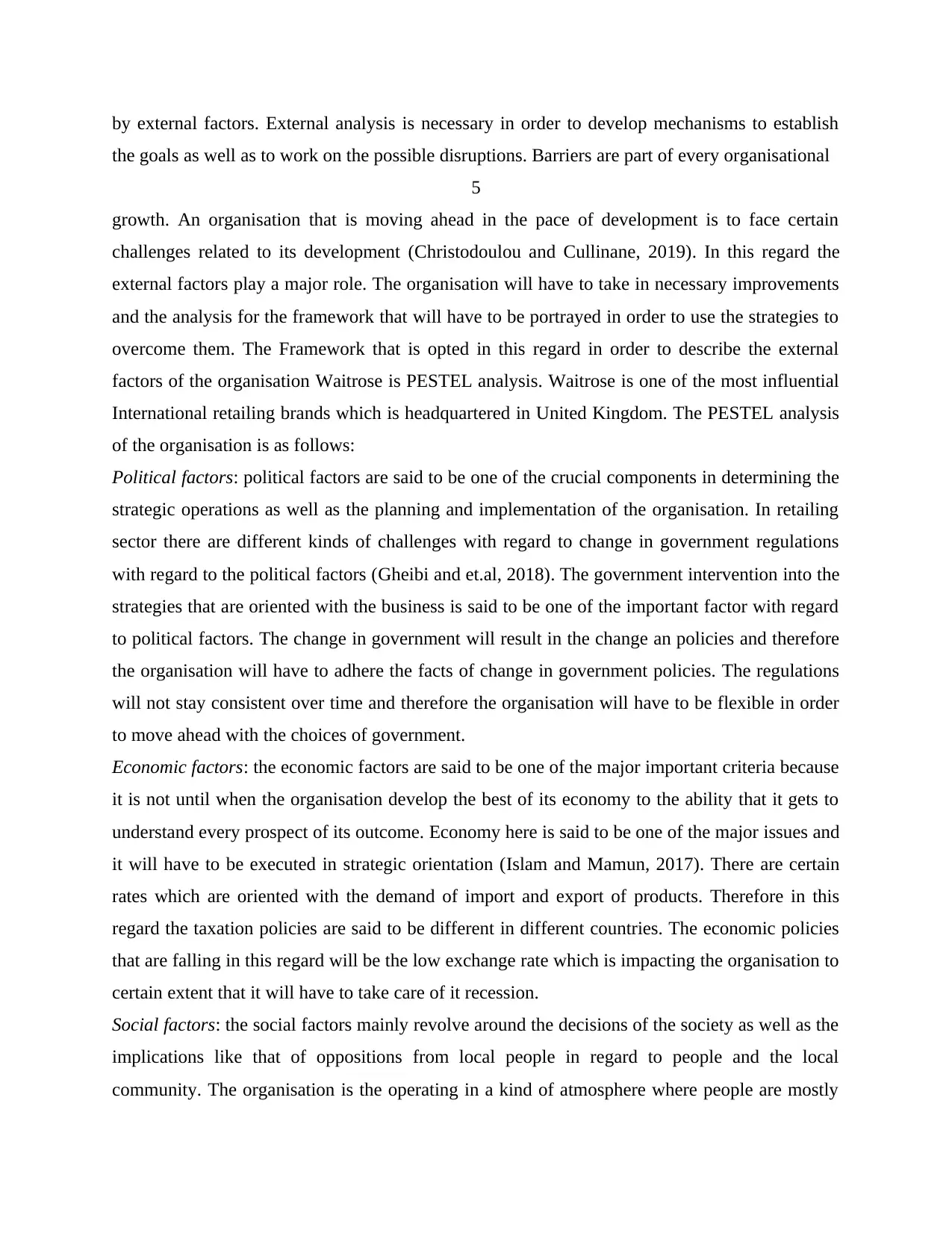
by external factors. External analysis is necessary in order to develop mechanisms to establish
the goals as well as to work on the possible disruptions. Barriers are part of every organisational
5
growth. An organisation that is moving ahead in the pace of development is to face certain
challenges related to its development (Christodoulou and Cullinane, 2019). In this regard the
external factors play a major role. The organisation will have to take in necessary improvements
and the analysis for the framework that will have to be portrayed in order to use the strategies to
overcome them. The Framework that is opted in this regard in order to describe the external
factors of the organisation Waitrose is PESTEL analysis. Waitrose is one of the most influential
International retailing brands which is headquartered in United Kingdom. The PESTEL analysis
of the organisation is as follows:
Political factors: political factors are said to be one of the crucial components in determining the
strategic operations as well as the planning and implementation of the organisation. In retailing
sector there are different kinds of challenges with regard to change in government regulations
with regard to the political factors (Gheibi and et.al, 2018). The government intervention into the
strategies that are oriented with the business is said to be one of the important factor with regard
to political factors. The change in government will result in the change an policies and therefore
the organisation will have to adhere the facts of change in government policies. The regulations
will not stay consistent over time and therefore the organisation will have to be flexible in order
to move ahead with the choices of government.
Economic factors: the economic factors are said to be one of the major important criteria because
it is not until when the organisation develop the best of its economy to the ability that it gets to
understand every prospect of its outcome. Economy here is said to be one of the major issues and
it will have to be executed in strategic orientation (Islam and Mamun, 2017). There are certain
rates which are oriented with the demand of import and export of products. Therefore in this
regard the taxation policies are said to be different in different countries. The economic policies
that are falling in this regard will be the low exchange rate which is impacting the organisation to
certain extent that it will have to take care of it recession.
Social factors: the social factors mainly revolve around the decisions of the society as well as the
implications like that of oppositions from local people in regard to people and the local
community. The organisation is the operating in a kind of atmosphere where people are mostly
the goals as well as to work on the possible disruptions. Barriers are part of every organisational
5
growth. An organisation that is moving ahead in the pace of development is to face certain
challenges related to its development (Christodoulou and Cullinane, 2019). In this regard the
external factors play a major role. The organisation will have to take in necessary improvements
and the analysis for the framework that will have to be portrayed in order to use the strategies to
overcome them. The Framework that is opted in this regard in order to describe the external
factors of the organisation Waitrose is PESTEL analysis. Waitrose is one of the most influential
International retailing brands which is headquartered in United Kingdom. The PESTEL analysis
of the organisation is as follows:
Political factors: political factors are said to be one of the crucial components in determining the
strategic operations as well as the planning and implementation of the organisation. In retailing
sector there are different kinds of challenges with regard to change in government regulations
with regard to the political factors (Gheibi and et.al, 2018). The government intervention into the
strategies that are oriented with the business is said to be one of the important factor with regard
to political factors. The change in government will result in the change an policies and therefore
the organisation will have to adhere the facts of change in government policies. The regulations
will not stay consistent over time and therefore the organisation will have to be flexible in order
to move ahead with the choices of government.
Economic factors: the economic factors are said to be one of the major important criteria because
it is not until when the organisation develop the best of its economy to the ability that it gets to
understand every prospect of its outcome. Economy here is said to be one of the major issues and
it will have to be executed in strategic orientation (Islam and Mamun, 2017). There are certain
rates which are oriented with the demand of import and export of products. Therefore in this
regard the taxation policies are said to be different in different countries. The economic policies
that are falling in this regard will be the low exchange rate which is impacting the organisation to
certain extent that it will have to take care of it recession.
Social factors: the social factors mainly revolve around the decisions of the society as well as the
implications like that of oppositions from local people in regard to people and the local
community. The organisation is the operating in a kind of atmosphere where people are mostly
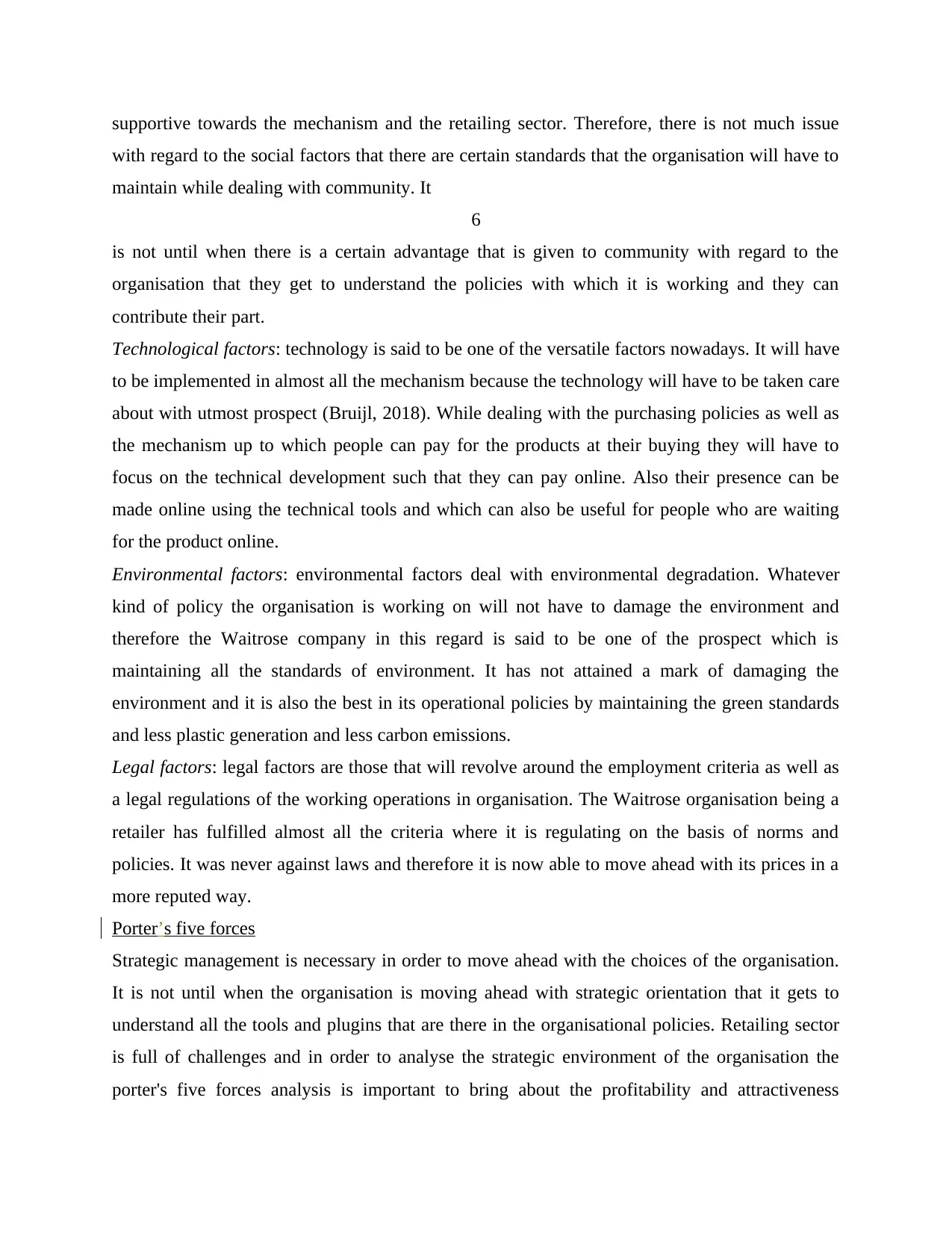
supportive towards the mechanism and the retailing sector. Therefore, there is not much issue
with regard to the social factors that there are certain standards that the organisation will have to
maintain while dealing with community. It
6
is not until when there is a certain advantage that is given to community with regard to the
organisation that they get to understand the policies with which it is working and they can
contribute their part.
Technological factors: technology is said to be one of the versatile factors nowadays. It will have
to be implemented in almost all the mechanism because the technology will have to be taken care
about with utmost prospect (Bruijl, 2018). While dealing with the purchasing policies as well as
the mechanism up to which people can pay for the products at their buying they will have to
focus on the technical development such that they can pay online. Also their presence can be
made online using the technical tools and which can also be useful for people who are waiting
for the product online.
Environmental factors: environmental factors deal with environmental degradation. Whatever
kind of policy the organisation is working on will not have to damage the environment and
therefore the Waitrose company in this regard is said to be one of the prospect which is
maintaining all the standards of environment. It has not attained a mark of damaging the
environment and it is also the best in its operational policies by maintaining the green standards
and less plastic generation and less carbon emissions.
Legal factors: legal factors are those that will revolve around the employment criteria as well as
a legal regulations of the working operations in organisation. The Waitrose organisation being a
retailer has fulfilled almost all the criteria where it is regulating on the basis of norms and
policies. It was never against laws and therefore it is now able to move ahead with its prices in a
more reputed way.
Porter’s five forces
Strategic management is necessary in order to move ahead with the choices of the organisation.
It is not until when the organisation is moving ahead with strategic orientation that it gets to
understand all the tools and plugins that are there in the organisational policies. Retailing sector
is full of challenges and in order to analyse the strategic environment of the organisation the
porter's five forces analysis is important to bring about the profitability and attractiveness
with regard to the social factors that there are certain standards that the organisation will have to
maintain while dealing with community. It
6
is not until when there is a certain advantage that is given to community with regard to the
organisation that they get to understand the policies with which it is working and they can
contribute their part.
Technological factors: technology is said to be one of the versatile factors nowadays. It will have
to be implemented in almost all the mechanism because the technology will have to be taken care
about with utmost prospect (Bruijl, 2018). While dealing with the purchasing policies as well as
the mechanism up to which people can pay for the products at their buying they will have to
focus on the technical development such that they can pay online. Also their presence can be
made online using the technical tools and which can also be useful for people who are waiting
for the product online.
Environmental factors: environmental factors deal with environmental degradation. Whatever
kind of policy the organisation is working on will not have to damage the environment and
therefore the Waitrose company in this regard is said to be one of the prospect which is
maintaining all the standards of environment. It has not attained a mark of damaging the
environment and it is also the best in its operational policies by maintaining the green standards
and less plastic generation and less carbon emissions.
Legal factors: legal factors are those that will revolve around the employment criteria as well as
a legal regulations of the working operations in organisation. The Waitrose organisation being a
retailer has fulfilled almost all the criteria where it is regulating on the basis of norms and
policies. It was never against laws and therefore it is now able to move ahead with its prices in a
more reputed way.
Porter’s five forces
Strategic management is necessary in order to move ahead with the choices of the organisation.
It is not until when the organisation is moving ahead with strategic orientation that it gets to
understand all the tools and plugins that are there in the organisational policies. Retailing sector
is full of challenges and in order to analyse the strategic environment of the organisation the
porter's five forces analysis is important to bring about the profitability and attractiveness
Paraphrase This Document
Need a fresh take? Get an instant paraphrase of this document with our AI Paraphraser
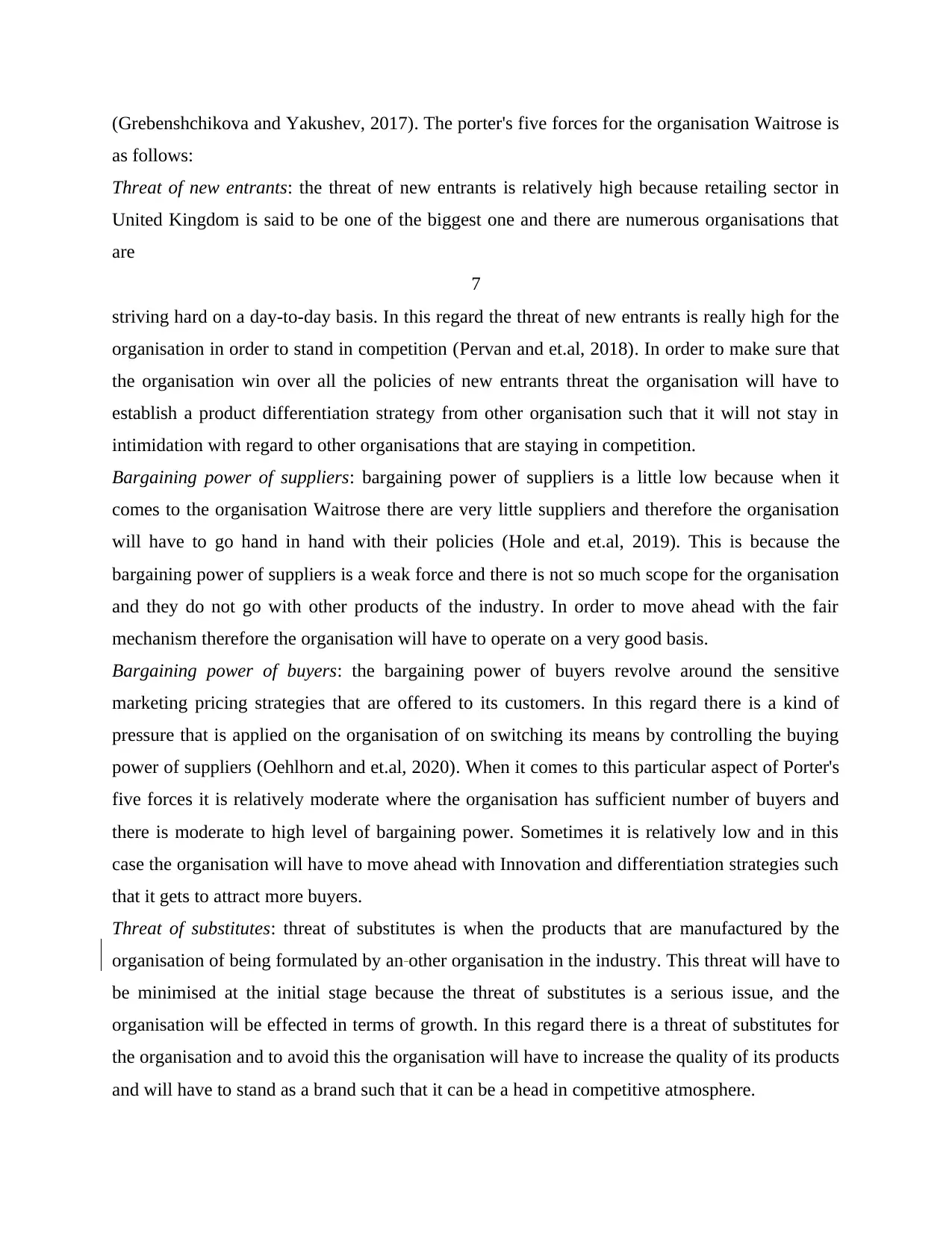
(Grebenshchikova and Yakushev, 2017). The porter's five forces for the organisation Waitrose is
as follows:
Threat of new entrants: the threat of new entrants is relatively high because retailing sector in
United Kingdom is said to be one of the biggest one and there are numerous organisations that
are
7
striving hard on a day-to-day basis. In this regard the threat of new entrants is really high for the
organisation in order to stand in competition (Pervan and et.al, 2018). In order to make sure that
the organisation win over all the policies of new entrants threat the organisation will have to
establish a product differentiation strategy from other organisation such that it will not stay in
intimidation with regard to other organisations that are staying in competition.
Bargaining power of suppliers: bargaining power of suppliers is a little low because when it
comes to the organisation Waitrose there are very little suppliers and therefore the organisation
will have to go hand in hand with their policies (Hole and et.al, 2019). This is because the
bargaining power of suppliers is a weak force and there is not so much scope for the organisation
and they do not go with other products of the industry. In order to move ahead with the fair
mechanism therefore the organisation will have to operate on a very good basis.
Bargaining power of buyers: the bargaining power of buyers revolve around the sensitive
marketing pricing strategies that are offered to its customers. In this regard there is a kind of
pressure that is applied on the organisation of on switching its means by controlling the buying
power of suppliers (Oehlhorn and et.al, 2020). When it comes to this particular aspect of Porter's
five forces it is relatively moderate where the organisation has sufficient number of buyers and
there is moderate to high level of bargaining power. Sometimes it is relatively low and in this
case the organisation will have to move ahead with Innovation and differentiation strategies such
that it gets to attract more buyers.
Threat of substitutes: threat of substitutes is when the products that are manufactured by the
organisation of being formulated by an other organisation in the industry. This threat will have to
be minimised at the initial stage because the threat of substitutes is a serious issue, and the
organisation will be effected in terms of growth. In this regard there is a threat of substitutes for
the organisation and to avoid this the organisation will have to increase the quality of its products
and will have to stand as a brand such that it can be a head in competitive atmosphere.
as follows:
Threat of new entrants: the threat of new entrants is relatively high because retailing sector in
United Kingdom is said to be one of the biggest one and there are numerous organisations that
are
7
striving hard on a day-to-day basis. In this regard the threat of new entrants is really high for the
organisation in order to stand in competition (Pervan and et.al, 2018). In order to make sure that
the organisation win over all the policies of new entrants threat the organisation will have to
establish a product differentiation strategy from other organisation such that it will not stay in
intimidation with regard to other organisations that are staying in competition.
Bargaining power of suppliers: bargaining power of suppliers is a little low because when it
comes to the organisation Waitrose there are very little suppliers and therefore the organisation
will have to go hand in hand with their policies (Hole and et.al, 2019). This is because the
bargaining power of suppliers is a weak force and there is not so much scope for the organisation
and they do not go with other products of the industry. In order to move ahead with the fair
mechanism therefore the organisation will have to operate on a very good basis.
Bargaining power of buyers: the bargaining power of buyers revolve around the sensitive
marketing pricing strategies that are offered to its customers. In this regard there is a kind of
pressure that is applied on the organisation of on switching its means by controlling the buying
power of suppliers (Oehlhorn and et.al, 2020). When it comes to this particular aspect of Porter's
five forces it is relatively moderate where the organisation has sufficient number of buyers and
there is moderate to high level of bargaining power. Sometimes it is relatively low and in this
case the organisation will have to move ahead with Innovation and differentiation strategies such
that it gets to attract more buyers.
Threat of substitutes: threat of substitutes is when the products that are manufactured by the
organisation of being formulated by an other organisation in the industry. This threat will have to
be minimised at the initial stage because the threat of substitutes is a serious issue, and the
organisation will be effected in terms of growth. In this regard there is a threat of substitutes for
the organisation and to avoid this the organisation will have to increase the quality of its products
and will have to stand as a brand such that it can be a head in competitive atmosphere.
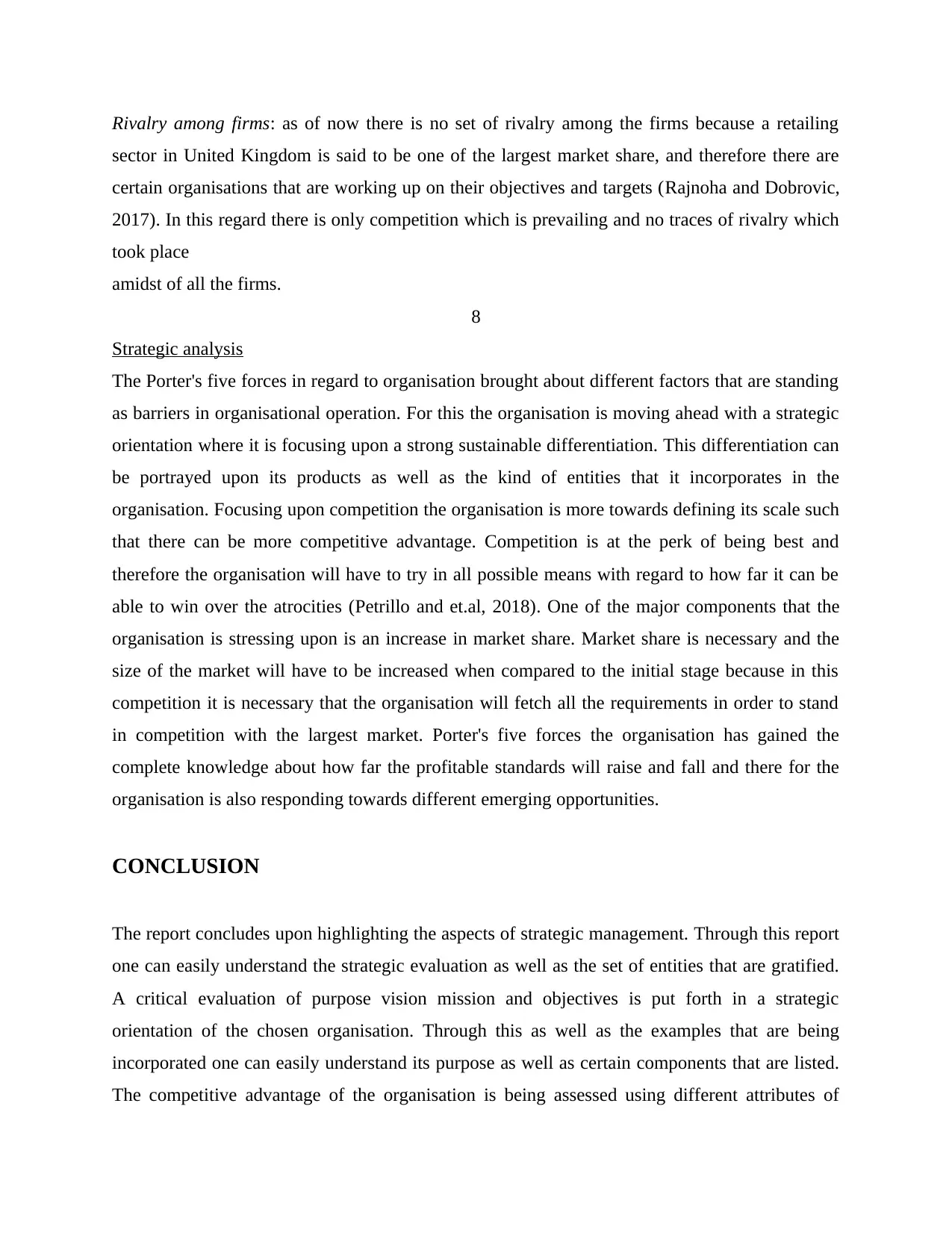
Rivalry among firms: as of now there is no set of rivalry among the firms because a retailing
sector in United Kingdom is said to be one of the largest market share, and therefore there are
certain organisations that are working up on their objectives and targets (Rajnoha and Dobrovic,
2017). In this regard there is only competition which is prevailing and no traces of rivalry which
took place
amidst of all the firms.
8
Strategic analysis
The Porter's five forces in regard to organisation brought about different factors that are standing
as barriers in organisational operation. For this the organisation is moving ahead with a strategic
orientation where it is focusing upon a strong sustainable differentiation. This differentiation can
be portrayed upon its products as well as the kind of entities that it incorporates in the
organisation. Focusing upon competition the organisation is more towards defining its scale such
that there can be more competitive advantage. Competition is at the perk of being best and
therefore the organisation will have to try in all possible means with regard to how far it can be
able to win over the atrocities (Petrillo and et.al, 2018). One of the major components that the
organisation is stressing upon is an increase in market share. Market share is necessary and the
size of the market will have to be increased when compared to the initial stage because in this
competition it is necessary that the organisation will fetch all the requirements in order to stand
in competition with the largest market. Porter's five forces the organisation has gained the
complete knowledge about how far the profitable standards will raise and fall and there for the
organisation is also responding towards different emerging opportunities.
CONCLUSION
The report concludes upon highlighting the aspects of strategic management. Through this report
one can easily understand the strategic evaluation as well as the set of entities that are gratified.
A critical evaluation of purpose vision mission and objectives is put forth in a strategic
orientation of the chosen organisation. Through this as well as the examples that are being
incorporated one can easily understand its purpose as well as certain components that are listed.
The competitive advantage of the organisation is being assessed using different attributes of
sector in United Kingdom is said to be one of the largest market share, and therefore there are
certain organisations that are working up on their objectives and targets (Rajnoha and Dobrovic,
2017). In this regard there is only competition which is prevailing and no traces of rivalry which
took place
amidst of all the firms.
8
Strategic analysis
The Porter's five forces in regard to organisation brought about different factors that are standing
as barriers in organisational operation. For this the organisation is moving ahead with a strategic
orientation where it is focusing upon a strong sustainable differentiation. This differentiation can
be portrayed upon its products as well as the kind of entities that it incorporates in the
organisation. Focusing upon competition the organisation is more towards defining its scale such
that there can be more competitive advantage. Competition is at the perk of being best and
therefore the organisation will have to try in all possible means with regard to how far it can be
able to win over the atrocities (Petrillo and et.al, 2018). One of the major components that the
organisation is stressing upon is an increase in market share. Market share is necessary and the
size of the market will have to be increased when compared to the initial stage because in this
competition it is necessary that the organisation will fetch all the requirements in order to stand
in competition with the largest market. Porter's five forces the organisation has gained the
complete knowledge about how far the profitable standards will raise and fall and there for the
organisation is also responding towards different emerging opportunities.
CONCLUSION
The report concludes upon highlighting the aspects of strategic management. Through this report
one can easily understand the strategic evaluation as well as the set of entities that are gratified.
A critical evaluation of purpose vision mission and objectives is put forth in a strategic
orientation of the chosen organisation. Through this as well as the examples that are being
incorporated one can easily understand its purpose as well as certain components that are listed.
The competitive advantage of the organisation is being assessed using different attributes of

VRIO framework. The competitive advantage using this framework is portrayed in this regard.
In order to analyse the external environment of the business and with regard to the organisation
the PESTEL Framework is put forth highlighting the political economic social technological
legal and environmental factors. To understand the strategic orientation of the organisation as
well as how far the organisational policies can attract the customers porter's five forces is used in
order to move ahead with strategic orientation. An analysis based on this theory is also explained
in this report.
9
REFERENCES
Books and journals
Bautista, A. and et.al., 2019, August. Strategic planning model to increase the profitability of an
HR outsourcing SME through digital transformation. In International Conference on
Human Interaction and Emerging Technologies (pp. 856-862). Springer, Cham.
Bruijl, 2018. The relevance of Porter's five forces in today's innovative and changing business
environment. Available at SSRN 3192207.
Bryson, J.M., Edwards, L.H. and Van Slyke, D.M., 2018. Getting strategic about strategic
planning research.
Carreras, A.B.L., Arroyo, J.C. and Blanco, J.E.E., 2018. Influence of the strategic planning and
the management skills as factors internal of business competitiveness of
SME’s. Contaduria y Administracion. 63(3). pp.9-10.
Casas, M. and et.al., 2019, August. Strategic Planning Model to Improve Competitiveness for
Service Industry SMEs Using the Balanced Scorecard. In International Conference
on Human Interaction and Emerging Technologies (pp. 1001-1006). Springer,
Cham.
Christodoulou and Cullinane, 2019. Identifying the main opportunities and challenges from the
implementation of a port energy management system: A SWOT/PESTLE analysis.
Sustainability. 11(21). p.6046.
Gheibi and et.al, 2018. Controlling air pollution in a city: A perspective from SOAR‐PESTLE
analysis. Integrated environmental assessment and management. 14(4). pp.480-488.
Grebenshchikova and Yakushev, 2017. Definition of Competitiveness of the Enterprise Using
the Five Forces of M. Porter. Vestnik IzGTU imeni MT Kalasnikova. 20(3). pp.51-
53.
Hole and et.al, 2019. Porter's five forces model: gives you a competitive advantage. Journal of
Advanced Research in Dynamical and Control System. 11(4). pp.1436-1448.
Islam and Mamun, 2017. Possibilities and challenges of implementing renewable energy in the
light of PESTLE & SWOT analyses for island countries. In Smart Energy Grid
Design for Island Countries (pp. 1-19). Springer, Cham.
Kornelius, H. and et.al., 2020. Competitive Strategic Maneuverability: The Missing Link
Between Strategic Planning and Firm’s Performance.
In order to analyse the external environment of the business and with regard to the organisation
the PESTEL Framework is put forth highlighting the political economic social technological
legal and environmental factors. To understand the strategic orientation of the organisation as
well as how far the organisational policies can attract the customers porter's five forces is used in
order to move ahead with strategic orientation. An analysis based on this theory is also explained
in this report.
9
REFERENCES
Books and journals
Bautista, A. and et.al., 2019, August. Strategic planning model to increase the profitability of an
HR outsourcing SME through digital transformation. In International Conference on
Human Interaction and Emerging Technologies (pp. 856-862). Springer, Cham.
Bruijl, 2018. The relevance of Porter's five forces in today's innovative and changing business
environment. Available at SSRN 3192207.
Bryson, J.M., Edwards, L.H. and Van Slyke, D.M., 2018. Getting strategic about strategic
planning research.
Carreras, A.B.L., Arroyo, J.C. and Blanco, J.E.E., 2018. Influence of the strategic planning and
the management skills as factors internal of business competitiveness of
SME’s. Contaduria y Administracion. 63(3). pp.9-10.
Casas, M. and et.al., 2019, August. Strategic Planning Model to Improve Competitiveness for
Service Industry SMEs Using the Balanced Scorecard. In International Conference
on Human Interaction and Emerging Technologies (pp. 1001-1006). Springer,
Cham.
Christodoulou and Cullinane, 2019. Identifying the main opportunities and challenges from the
implementation of a port energy management system: A SWOT/PESTLE analysis.
Sustainability. 11(21). p.6046.
Gheibi and et.al, 2018. Controlling air pollution in a city: A perspective from SOAR‐PESTLE
analysis. Integrated environmental assessment and management. 14(4). pp.480-488.
Grebenshchikova and Yakushev, 2017. Definition of Competitiveness of the Enterprise Using
the Five Forces of M. Porter. Vestnik IzGTU imeni MT Kalasnikova. 20(3). pp.51-
53.
Hole and et.al, 2019. Porter's five forces model: gives you a competitive advantage. Journal of
Advanced Research in Dynamical and Control System. 11(4). pp.1436-1448.
Islam and Mamun, 2017. Possibilities and challenges of implementing renewable energy in the
light of PESTLE & SWOT analyses for island countries. In Smart Energy Grid
Design for Island Countries (pp. 1-19). Springer, Cham.
Kornelius, H. and et.al., 2020. Competitive Strategic Maneuverability: The Missing Link
Between Strategic Planning and Firm’s Performance.
Secure Best Marks with AI Grader
Need help grading? Try our AI Grader for instant feedback on your assignments.

Leyva Carreras, A.B., Cavazos Arroyo, J. and Espejel Blanco, J.E., 2018. Influence of the
strategic planning and the management skills as factors internal of business
competitiveness of SME’s. Contaduría y administración. 63(3). pp.0-0.
Oehlhorn and et.al, 2020. Human resource management and its impact on strategic business-IT
alignment: A literature review and avenues for future research. The Journal of
Strategic Information Systems, p.101641.
Pervan and et.al, 2018. The influence of industry characteristics and dynamic capabilities on
firms’ profitability. International Journal of Financial Studies. 6(1). p.4.
Petrillo and et.al, 2018. Building excellence through the Agile Reengineering Performance
Model (ARPM): A strategic business model for organizations. Business Process
Management Journal.
Rajnoha and Dobrovic, 2017. Managerial information support for strategic business performance
management in industrial enterprises in Slovakia. Polish journal of management
studies. 15.
10
Rizan, M., Balfas, F. and Purwohedi, U., 2019. The influence of strategic orientation,
organizational innovation capabilities and strategic planning on the performance of
technology-based firms. Academy of Strategic Management Journal. 18(3). pp.1-11.
Rofiq, A. and Pramono, S., 2019. The role of strategic planning and flexibility in shaping SMEs
market orientation in turbulence business environment.
Tarigan, Z. and Siagian, H., 2021. The effects of strategic planning, purchasing strategy and
strategic partnership on operational performance. Uncertain Supply Chain
Management. 9(2). pp.363-372.
Teixeira, G.F.G. and Junior, O.C., 2019. How to make strategic planning for corporate
sustainability?. Journal of Cleaner Production. 230. pp.1421-1431.
Online
About Waitrose & Partners,2019. [Online]. Accessed through <
strategic planning and the management skills as factors internal of business
competitiveness of SME’s. Contaduría y administración. 63(3). pp.0-0.
Oehlhorn and et.al, 2020. Human resource management and its impact on strategic business-IT
alignment: A literature review and avenues for future research. The Journal of
Strategic Information Systems, p.101641.
Pervan and et.al, 2018. The influence of industry characteristics and dynamic capabilities on
firms’ profitability. International Journal of Financial Studies. 6(1). p.4.
Petrillo and et.al, 2018. Building excellence through the Agile Reengineering Performance
Model (ARPM): A strategic business model for organizations. Business Process
Management Journal.
Rajnoha and Dobrovic, 2017. Managerial information support for strategic business performance
management in industrial enterprises in Slovakia. Polish journal of management
studies. 15.
10
Rizan, M., Balfas, F. and Purwohedi, U., 2019. The influence of strategic orientation,
organizational innovation capabilities and strategic planning on the performance of
technology-based firms. Academy of Strategic Management Journal. 18(3). pp.1-11.
Rofiq, A. and Pramono, S., 2019. The role of strategic planning and flexibility in shaping SMEs
market orientation in turbulence business environment.
Tarigan, Z. and Siagian, H., 2021. The effects of strategic planning, purchasing strategy and
strategic partnership on operational performance. Uncertain Supply Chain
Management. 9(2). pp.363-372.
Teixeira, G.F.G. and Junior, O.C., 2019. How to make strategic planning for corporate
sustainability?. Journal of Cleaner Production. 230. pp.1421-1431.
Online
About Waitrose & Partners,2019. [Online]. Accessed through <

11
1 out of 12
Related Documents
Your All-in-One AI-Powered Toolkit for Academic Success.
+13062052269
info@desklib.com
Available 24*7 on WhatsApp / Email
![[object Object]](/_next/static/media/star-bottom.7253800d.svg)
Unlock your academic potential
© 2024 | Zucol Services PVT LTD | All rights reserved.



